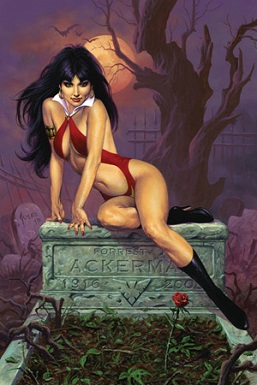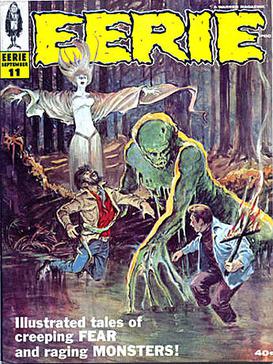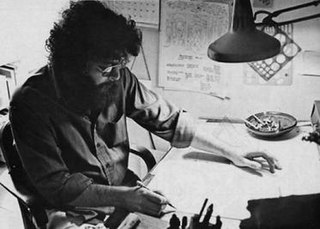Publishing history
Founding

Begun by James Warren, Warren Publishing's initial publications were the horror-fantasy--science fiction movie magazine Famous Monsters of Filmland and Monster World, both edited by Forrest J Ackerman. Warren soon published Spacemen magazine and in 1960 Help! magazine, with the first employee of the magazine being Gloria Steinem. [1]
After introducing what he called "Monster Comics" in Monster World, Warren expanded in 1964 with horror-comics stories in the sister magazines Creepy and Eerie – black-and-white publications in a standard magazine format, rather than comic-book size, and selling for 35 cents as opposed to the standard comic-book price of 12 cents. Such a format, Warren explained, averted the restrictions of the Comics Code Authority, the comic-book industry's self-censorship body:
The Comics Code saved the industry from turmoil, but at the same time, it had a cleansing kind of effect on comics, making them "clean, proper and family-oriented" ... We would overcome this by saying to the Code Authority, the industry, the printers, and the distributors: 'We are not a comic book; we are a magazine. Creepy is magazine-sized and will be sold on magazine racks, not comic book racks". Creepy's manifesto was brief and direct: First, it was to be a magazine format, 8½" × 11", going to an older audience not subject to the Code Authority." [2]
By publishing graphic stories in a magazine format to which the Code did not apply, Warren paved the way for such later graphic-story magazines as the American version of Heavy Metal ; Marvel Comics' Epic Illustrated ; and Psycho and other series from Skywald Publications.
Russ Jones was the founding editor of Creepy in 1964. A year later, Archie Goodwin succeeded him, with Joe Orlando acting as a behind-the-scenes story editor. [3] Goodwin, who would become one of comics' foremost and most influential writers, helped to establish the company as a leader in its field. From 1965 to 1966, Warren also published the four-issue Blazing Combat , a war-comics magazine with anti-war themes, controversial at the time. [1] [4]
Vampirella and international artists
After 17 issues of Creepy and 11 of Eerie, Goodwin resigned as editor in 1967. The movement of Warren's operations from Philadelphia to New York City, combined with a change in distributors and a downturn in the market imposed a cash flow problem on Warren, and Goodwin along with all of the artists except for Tom Sutton and Rocke Mastroserio (who soon died) departed the company. [5]
During the next two-and-a-half years, Warren's publications consisted primarily of reprints from the early issues. During this period, a variety of editors ran the magazines including Bill Parente, Nicola Cuti, and Warren himself. Things started picking up again for Warren in 1969 with the premiere of its third horror magazine, Vampirella . Many of Warren's original artists returned during this period, as would Goodwin for a period of time in 1970 and 1971. After Goodwin's second departure, editors would J.R. Cochran. The art director was Billy Graham.
In 1971, Warren began using artists from the Barcelona studio of Spanish agency Selecciones Illustrada. Over the next few years, Spanish artists would dominate the magazines. Additional Spanish artists from S.I.'s Valencia studio began freelancing for Warren in 1974.
In 1973, new editor Bill DuBay, who had originally joined the company as an artist early in 1970, transformed Warren's magazines to create a uniform style. The following year, Warren Publishing was dissolved and replaced by Warren Communications, a sister company James Warren had founded in 1972. Dubay was editor for all three of Warren's horror magazines until 1976, except for a short period of time in 1974 where Goodwin returned to edit four issues of Creepy and two of Vampirella. During this time, the frequency of Warren's magazines was increased to nine issues a year.
Line expansion in the 1970s
In 1974, DuBay oversaw a new black-and-white magazine, The Spirit , which revived acclaimed writer-artist Will Eisner's masked detective of 1940s and early-1950s newspaper Sunday supplements, reprinting the character's seven-page, semi-anthological stories for a new generation. The magazine featured new covers by Eisner and an occasional reprint in color.( The Spirit would later move to Kitchen Sink Press.) The same year, Warren debuted Comix International , a color magazine reprinting earlier Warren stories.
After Dubay's departure, Louise Jones, his former assistant, headed the editorial staff from 1976 to 1980. Toward the end of Dubay's period of editorship many American artists had returned to the magazines, including John Severin, Alex Toth, and Russ Heath and they contributed many stories during Jones' time as editor. Former DC Comics publisher Carmine Infantino would also join the company during this period and pencil over 50 stories. Much like the wave of Spanish artists that dominated throughout the mid-1970s, a number of artists from the Philippines would begin contributing during this period. Dubay returned as editor after Jones' departure, using the alias "Will Richardson".
Toward the end of the 1970s, Warren published two new magazines edited by Dubay: the science-fiction anthology 1984 , in 1978 (which would change its name to 1994 two years later); and, in 1979, The Rook , starring a time-traveling adventurer whose stories had appeared in Eerie since 1977.
Decline and bankruptcy
James Warren's bad health, combined with changing tastes and business problems, led to internal turmoil and editorial turnover. [6] [7] The company suspended publishing in late 1981, [8] editor Bill Dubay left in 1982, [9] and Warren declared bankruptcy in 1983.[ citation needed ] In August 1983, Harris Publications acquired company assets at auction, [10] and published new and reprinted Vampirella comics; Creepy #146 (Summer 1985), continuing the numbering of the original series and containing both new and reprinted material, [11] Creepy: The Limited Series, a four-issue miniseries of new stories; [12] and other Warren-related comics. A 1998 lawsuit by James Warren [13] resulted in his reacquisition of the rights to Creepy and Eerie. Dark Horse Comics began issuing reprints with the ongoing licensed series Creepy Archives in 2008, [14] and began publishing new material with Creepy vol. 2 in 2009 [15] and Eerie vol. 2 in 2012. [16]











